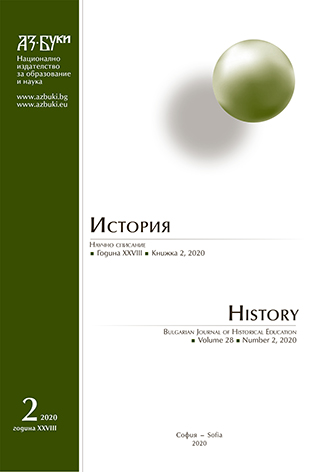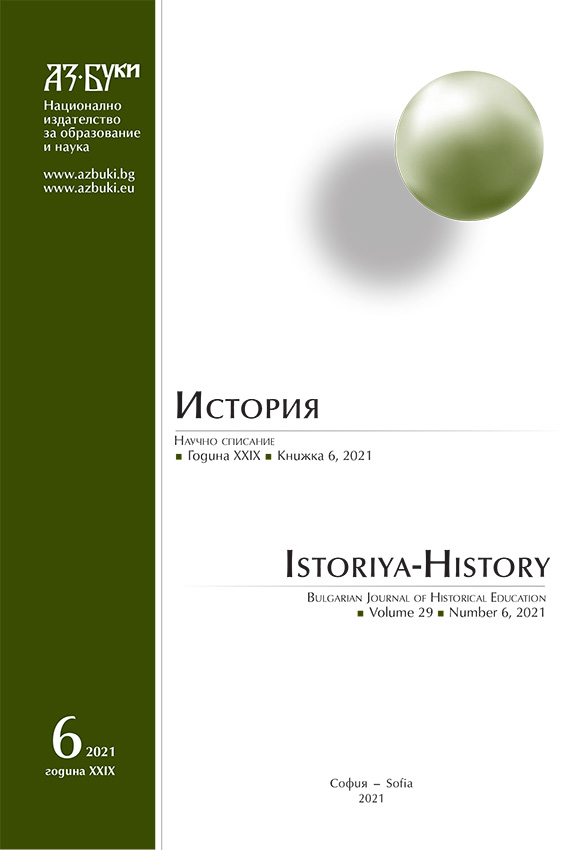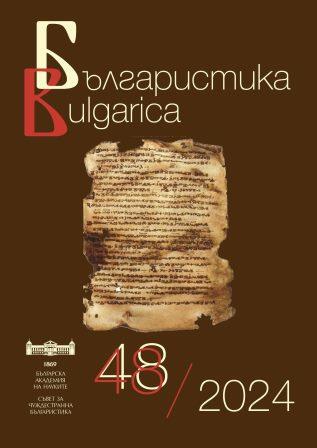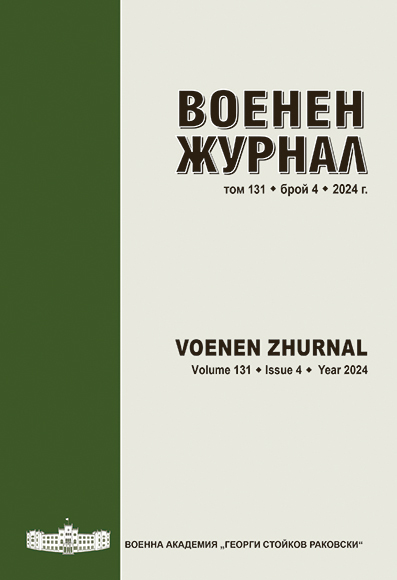
Научна периодика 2011–2012 г.
Content of the main Bulgarian scientific journals for the current year in linguistics, literature, history, folklore, ethnography, archaeology and art studies
More...We kindly inform you that, as long as the subject affiliation of our 300.000+ articles is in progress, you might get unsufficient or no results on your third level or second level search. In this case, please broaden your search criteria.

Content of the main Bulgarian scientific journals for the current year in linguistics, literature, history, folklore, ethnography, archaeology and art studies
More...
The aim of the paper is to investigate the regional elite of Šariš and its weekly, Naša Zastava which was published in an Eastern Slovak dialect between 1907 – 1918. A considerable amount of Slovak and Hungarian works has been already published on the so-called Slovjak movement. The main sources of research were the documents of the so-called Public Educational Association of the Šariš County. The paper uses this organisation to examine the way how a regional elite contructs the imagined community of Eastern Slovak people before 1918.
More...
One of the typical and relatively stable features of the everyday life of the Bulgarianimmigrants in the historical and cultural region of Bessarabia are the patronal festivalsand customs held within the frameworks of the village, neighbourhood or familyand referred to as zbor/sabor (збор/събор), hram (храм), kurban (курбан), tsarkva(църква), panagir (панагирь), cherkuvane (черкуване), moleben (молебен) etc. Asfor the designation збор (a fair), it is clear that it precedes the Russian designationхрам (a patron saint’s day) which penetrates the region under study later on andwhich is widely used at present. What stirs up bigger interest is the fact that exceptfor village church festivals this term (as well as some of the other above-mentioned) was also used for intervillage festivals held at the landmark of the territories of two,three or more villages – the so-called fairs at the landmark also known as moleben orcherkuvane for rain and good health.As far as the patron saint’s day is a universal Christian phenomenon and stilla general practice in the villages of the region studied here, it could be assumedthat the gathering itself, the making of zbor (or moleben) at the landmark (at theborder between a group of villages), which is neglected today almost everywhere,is a form typical only of the immigrants (Bulgarians and Gagauzians) in Bessarabia.This practice attracts the attention with respect to its nature and development as partof the all-Bulgarian system of patronal village festivals as well as with relation tothe influences, changes and specifics through which it inevitably goes under theconditions of the many-tounged and polycultural environment of Bessarabia and theRussian Orthodox Christianity.The fieldwork materials collected so far do not allow a coprehensive and thickdescription of the phenomena intriguing us as well as a more elaborate analysis.That’s why the article only poses the problem or rather interpretes it in connectionwith some concepts of the kin and family-territorial patronal festivals and customswhich were formulated a long time ago in the Bulgarian science but which are stillrelevant.
More...
On the basis of written sources and field materials, the article examines the phenomenonof the “Odessa cuisine” as a regional complex of food. In the context of thehistorical dynamics, it shows the role of the Balkan traditions in the formation anddevelopment of the everyday culture of the inhabitants of Odessa. Special attentionis paid to the current state of the trade subculture and, respectively, to the systemof the food traditions in Odessa. In particular, the article shows that there are manyproducts introduced by natives from the Balkans (first of all, Greeks and Bulgarians):eggplants, tomatoes, cheese, corn, mutton, grapes, etc. The regional dishes perceivedas “Odessaian” but having roots in the ethno-cultures of the above-mentioned communities,are developed on this basis. The text shows also the “blue” (eggplants) invarious variations of preparation and the “pshonka” (corn). Beside the national, theprofessional mass cuisine is also analyzed (restaurant); in it the Balkan substratumhas found its place a long time ago along with the Jewish, Ukrainian and Moldavian.In the menu of these institutions, there are surely a number of dishes with Balkanorigins. On the other hand, it is worth characterizing the special national restaurantsof Odessa (Bulgarian, Gagauzian, Greek).
More...

The extension of totalitarian and authoritarian regimes in the first half of the twentieth century, which hit most European states, required political interferences within the highest legislative and executive authorities of states as well as in local administrations and bodies of self-government. Legislative interventions resulted in the formation of new local political elites whose representatives, mostly recruited by the criterion of political reliability, held the defining positions and played the significant role in implementing anti-Jewish policy during the Holocaust era. The main aim of this contribution is the analysis of the mechanisms of legislative interventions into the creation of new local political elites in selected examples of Nazi-occupied countries (General Government, Protectorate of Bohemia and Moravia) and allied regimes (Slovak State and Hungary).
More...
The purpose of this article is revealing the conditions and prerequisites for the “birth” of the entrepreneurial class in Sopot, Karlovo and Kalofer during the 18th-19th centuries. The main conclusion is that the combination of a favorable external environment and appropriate personal qualities make possible the appearance of people with enterprising spirit. In other words, Bulgarian Revival entrepreneurs from Sopot, Karlovo and Kalofer are born, but they are also made through the accumulated experience and knowledge.
More...
The article presents an unknown letter from the epistolary heritage of the Bogoridi family, in French in handwritten original, sent by Emanuel Bogoridi to his uncle Alexander Bogoridi, dated June 12, 1879, currently stored in the collection of the Bulgarian Historical Archive at the National Library “Ivan Vazov” – Plovdiv. The source and archeographic aspects of the newly discovered document are examined. In terms of content, the background of the idea of founding a museum, a library, an archive and a university in Eastern Rumelia and the involvement of one of the most famous European Slavic scholars in the person of Konstantin Irechek for this cause are presented. By publishing the letter in Bulgarian for the first time, it is included in scientific circulation.
More...

The article examines the activities of the established at the end of 1946 Pan-Slavic Committee in Belgrade which, however, lasted only a year and a half. The Committee was created with the intention of being the centralized and ruling body of the Kremlin-born Slavic Movement after June 22, 1941. The emergence of the Committee came at a time when relations between the partners of the Anti-Axis Coalition had begun to deteriorate, and this circumstance inevitably made a direct impact on the tasks it was assigned. After the final bloc division of Europe and the Tito – Stalin split, the very existence of the Pan-Slavic Committee became meaningless, since the political exploitation of the idea of Slavic unity no longer fitted into the new realities and this resulted in its abolishment in the mid of 1948.
More...
Based on a politico-economic analysis, the paper provides answers to important questions about the April Uprising of 1876: why the Bulgarians revolted, why many Bulgarians did not revolt, and why the uprising was relatively short as a time-span. According to the available primary sources the Bulgarians who revolted in April 1876 revolted because they were relatively wealthy and as such they had something to lose. Revolutionary sentiments, however, did not prevail in their political views concerning the Bulgarian question. Here comes the role of the propaganda lie about the authority planned massacre of the Bulgarians. As a result, live and property of the future rebels, were considered as endangered. The response to the threat is a risky and desperate anti-state uprising. The organizers of the uprising did not overcome the free-rider problem. The population in the insurgent settlements was left to pay the price of putting the Bulgarian question before Europe. Additional difficulties in the implementation of a relatively mass riot pose the short deadlines for its preparation. They resulted in high prices of and do not allow the supply of larger quantities of weapons and gunpowder.
More...
The main thesis of this essay is the assertion of the concurrence of the Polish transformation after 1989 with the world switch towards the liberal international order at that time. Poland was among initiators of these changes and hugely benefited from them. It applied to the establishment of the regime of the rule of law and the open market economy. The success of the Polish transformation and the rapid economic growth would have not been possible or they would have been limited without this external support.The main although not the only theoretical explanation framework to these processes is the liberal school of thought. Democratic regress in Poland (since end of 2015) and a turn to authoritarianism coincide with backsliding of the international liberal order. Unfavourable internal changes incapacitate Poland’s foreign policy as well as its international standing.
More...
The publication of Emanuel Vaskidovitch „Kratko izlozhenieza saedinenieto na dvete uchilishta Svishtovski“ is known to the researchers, as an application of “Hristiyansko pouchenie ili sokrashtenie na Sveshtenniyata katihisisa” however to this day no researcher has commented upon the master copies which have been used for the making of the publication. „Kratko izlozhenie“in essence, it’s the first printed draft for the communities` statute in the Bulgarian language. In the present article i demonstrate my thesis, that the author adjusts the only known published statute of Greek Orthodox community from the early19th century „Sistyma i diatagai“, compounded from Melenikon’s citizens in 1813is made known to the Bulgarian public. Source of unmatched value, this statute provides us with precious information for the development of the subsidiarity, for the entry of social elements in the Melenikon’s administration, as for the rules which this happens.
More...
The article presents archival materials and other historical sources which keep primary information about the death and funeral of the famous Bulgarian rebel leader Hadzhi Dimitar Asenov (1840 – 1868) who originates from the town of Sliven. The widely accepted thesis that Hadzhi Dimitar was deadly shot during the Buzludzha battle (18th July 1868) and was buried at the place of the battle has been proven once again by bringing new motives and logical arguments. The funeral of the famous revolutionary on the Buzludzha peak (named in 1942 Hadzhi Dimitar peak) has been confirmed with memorial and archaeological pieces of evidence. Both re-burials of the fallen heroes (1898 and 1961) provide additional data in that direction. Despite scientific argumentation of the said thesis, the article also interprets some uncertain and contradictory evidence about the eventual death of Hadzhi Dimitar on the Kadrafil peak, located in the Sredna gora mountain – 50 km away from Bualudzha peak in the Stara planina mountain. Neither factual nor logical arguments of this legend withstand scientific criticism. Nevertheless, they are persistently popularized by local patriots, originating mainly from the village Svezhen (formerly called Ajar – until 1934). Furthermore, supporters of the so called Adjar's legend are trying to give national status of their unscientific claims about the death and burial of the famous revolutionary leader Hadzhi Dimitar Asenov. Their unjustified actions are conceptualized in the scientific context of the cultural memory theory. The dispute between the scientific version and the Adjar's legend is explained by the different approaches of historical science and cultural memory toward a single fact from the past – the last moments of a national hero's life. The professional historiography works with objective facts, scientific methods and logical arguments. Cultural memory attracts convenient hypotheses, mythological plots and unprovable local memories.
More...
Our study demonstrates that the analysis of culture should be embedded into the history of capitalism. Through this understanding of culture's materiality, we highlight that culture is not only a spiritual but also a materially embedded phenomenon. We argue that this analysis is also essential to outline culture's role in a post-capitalist world.Our study offers four perspectives to analyze the diverse, often indirect, relationship between culture and capitalism. We show how the diversity of culture is more than heterogeneity but rather part of class conflicts and struggles. By examining the cultural institutions, our paper points out that they play a crucial role in the reproduction of the laborforce. It also points out that global and nation-state-led cultural production are not contradictory but entangled phenomena. Finally, our paper emphasizes that the relationship between culture and capitalism cannot be understood as abstract laws but must also always consider the social trajectories of professional cultural producers, who are a central but often invisible dark matter.
More...
Content of the main Bulgarian scientific journals for the current year in linguistics, literature, history, folklore, ethnography, archaeology and art studies.
More...
Selected bibliography in the field of Bulgarian Studies published in the current year.
More...
The status of Mount Athos during the First Balkan War and the accompanying peace negotiations was a major issue for Russia, Greece and the Western Great Powers. Paradoxically, Bulgaria, which is one of the countries in the Balkan Union, shows almost no interest in this problem. Bulgarian diplomacy perceives it as a private case that has much more background positions than the big and important problem related to the territorial expansion in the White Sea region and Macedonia. The article answers the question why Bulgarian politics underestimates the importance of the problem related to the status of the monastic territory on the Athos peninsula and its importance for the international prestige of the state, as well as its geostrategic positioning on the Balkans.
More...
From the time it was colonized to the present day, the Democratic Republic of the Congo (DRC) has neither experienced democracy nor lasting peace and stability. Instead, it has all the qualitative attributes of a fragile state. Empirically, the beginnings of a fragile state are linked to rebellions which led to civil wars and thereafter took on a long-run trend with the capture and exploitation of resources. For example, diamonds in Sierra Leone, oil in Sudan and South Sudan and rare metals in DRC. Fragility stems from being in conflict repeatedly, a sign of a vicious cycle where conflict generates grievance and grievance generates further conflict. However recurring conflicts are also often driven by greed for resources whose control can fund a conflict ad infinitum especially if the resources are in demand globally. Hence the conflict becomes internationalized. The entry of international players is based on predatory opportunities to control commodity exports. Because the conflict also displaces people (and creates a rebellious diaspora), especially those with influence and money, these grievances fuel the discontent of diaspora which mobilizes funds to finance the conflict further.
More...
The Armenian-Azerbaijani conflict has been a visible constant on the international stage since 1988. On the Armenian side, the commemoration of the genocide of 1915 and the Soviet decision to attach Nagorno-Karabakh to Azerbaijan in 1921 appeared to be the main drivers to produce and reproduce „groupness”. Whereas Armenian nationalist narratives had first been silenced and then mitigated during the Soviet era, they have become decisive since the dissolution of the USSR. Armenian ethnopolitical entrepreneurs exploited them to establish a new political legitimacy. With the wars in 2020 and 2023, the tide turned in favour of Azerbaijan, as it managed to reconquer Nagorno-Karabakh and expel its Armenian population. Now, Azerbaijan appears as the main driver of the conflict when it utters claims for a corridor to Nakhchivan through the Armenian territory.
More...